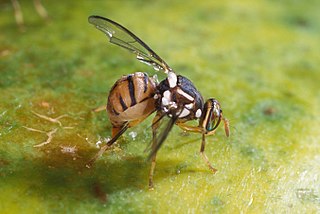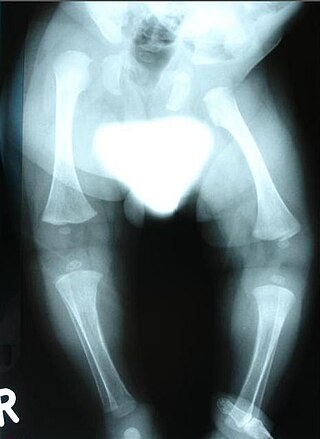Related Research Articles

Drosophila is a genus of flies, belonging to the family Drosophilidae, whose members are often called "small fruit flies" or pomace flies, vinegar flies, or wine flies, a reference to the characteristic of many species to linger around overripe or rotting fruit. They should not be confused with the Tephritidae, a related family, which are also called fruit flies ; tephritids feed primarily on unripe or ripe fruit, with many species being regarded as destructive agricultural pests, especially the Mediterranean fruit fly.

Halteres are a pair of small club-shaped organs on the body of two orders of flying insects that provide information about body rotations during flight. Insects of the large order Diptera (flies) have halteres which evolved from a pair of ancestral hindwings, while males of the much smaller order Strepsiptera (stylops) have halteres which evolved from a pair of ancestral forewings.

Flies are insects of the order Diptera, the name being derived from the Greek δι- di- "two", and πτερόν pteron "wing". Insects of this order use only a single pair of wings to fly, the hindwings having evolved into advanced mechanosensory organs known as halteres, which act as high-speed sensors of rotational movement and allow dipterans to perform advanced aerobatics. Diptera is a large order containing an estimated 1,000,000 species including horse-flies, crane flies, hoverflies and others, although only about 125,000 species have been described.

Drosophila melanogaster is a species of fly in the family Drosophilidae. The species is often referred to as the fruit fly or lesser fruit fly, or less commonly the "vinegar fly" or "pomace fly". Starting with Charles W. Woodworth's 1901 proposal of the use of this species as a model organism, D. melanogaster continues to be widely used for biological research in genetics, physiology, microbial pathogenesis, and life history evolution. As of 2017, five Nobel Prizes have been awarded to drosophilists for their work using the insect.

Spinal muscular atrophies (SMAs) are a genetically and clinically heterogeneous group of rare debilitating disorders characterised by the degeneration of lower motor neurons and subsequent atrophy (wasting) of various muscle groups in the body. While some SMAs lead to early infant death, other diseases of this group permit normal adult life with only mild weakness.

Octopamine (molecular formula C8H11NO2; also known as OA, and also norsynephrine, para-octopamine and others) is an organic chemical closely related to norepinephrine, and synthesized biologically by a homologous pathway. Octopamine is often considered the major "fight-or-flight" neurohormone of invertebrates. Its name is derived from the fact that it was first identified in the salivary glands of the octopus.

The Tephritidae are one of two fly families referred to as fruit flies, the other family being the Drosophilidae. The family Tephritidae does not include the biological model organisms of the genus Drosophila, which is often called the "common fruit fly". Nearly 5,000 described species of tephritid fruit fly are categorized in almost 500 genera of the Tephritidae. Description, recategorization, and genetic analyses are constantly changing the taxonomy of this family. To distinguish them from the Drosophilidae, the Tephritidae are sometimes called peacock flies, in reference to their elaborate and colorful markings. The name comes from the Greek τεφρος, tephros, meaning "ash grey". They are found in all the biogeographic realms.

The Queensland fruit fly is a species of fly in the family Tephritidae in the insect order Diptera. B. tryoni is native to subtropical coastal Queensland and northern New South Wales. They are active during the day, but mate at night. B. tryoni lay their eggs in fruit. The larvae then hatch and proceed to consume the fruit, causing the fruit to decay and drop prematurely. B. tryoni are responsible for an estimated $28.5 million a year in damage to Australian crops and are the most costly horticultural pest in Australia. Up to 100% of exposed fruit can be destroyed due to an infestation of this fly species. Previously, pesticides were used to eliminate B. tryoni from damaging crops. However, these chemicals are now banned. Thus, experts devoted to B. tryoni control have transitioned to studying this pests' behaviors to determine a new method of elimination.

A neuromuscular disease is any disease affecting the peripheral nervous system (PNS), the neuromuscular junction, or skeletal muscle, all of which are components of the motor unit. Damage to any of these structures can cause muscle atrophy and weakness. Issues with sensation can also occur.

Spinal muscular atrophy (SMA) is a rare neuromuscular disorder that results in the loss of motor neurons and progressive muscle wasting. It is usually diagnosed in infancy or early childhood and if left untreated it is the most common genetic cause of infant death. It may also appear later in life and then have a milder course of the disease. The common feature is progressive weakness of voluntary muscles, with arm, leg and respiratory muscles being affected first. Associated problems may include poor head control, difficulties swallowing, scoliosis, and joint contractures.

Bactrocera dorsalis, previously known as Dacus dorsalis and commonly referred to as the oriental fruit fly, is a species of tephritid fruit fly that is endemic to Southeast Asia. It is one of the major pest species in the genus Bactrocera with a broad host range of cultivated and wild fruits. Male B. dorsalis respond strongly to methyl eugenol, which is used to monitor and estimate populations, as well as to annihilate males as a form of pest control. They are also important pollinators and visitors of wild orchids, Bulbophyllum cheiri and Bulbophyllum vinaceum in Southeast Asia, which lure the flies using methyl eugenol.

Most animal testing involves invertebrates, especially Drosophila melanogaster, a fruit fly, and Caenorhabditis elegans, a nematode. These animals offer scientists many advantages over vertebrates, including their short life cycle, simple anatomy and the ease with which large numbers of individuals may be studied. Invertebrates are often cost-effective, as thousands of flies or nematodes can be housed in a single room.

X-linked spinal muscular atrophy type 2, also known as arthrogryposis multiplex congenita X-linked type 1 (AMCX1), is a rare neurological disorder involving death of motor neurons in the anterior horn of spinal cord resulting in generalised muscle wasting (atrophy). The disease is caused by a mutation in UBA1 gene and is passed in an X-linked recessive manner by carrier mothers to affected sons.

Distal spinal muscular atrophy type 1 (DSMA1), also known as spinal muscular atrophy with respiratory distress type 1 (SMARD1), is a rare neuromuscular disorder involving death of motor neurons in the spinal cord which leads to a generalised progressive atrophy of body muscles.

A genetically modified (GM) insect is an insect that has been genetically modified, either through mutagenesis, or more precise processes of transgenesis, or cisgenesis. Motivations for using GM insects include biological research purposes and genetic pest management. Genetic pest management capitalizes on recent advances in biotechnology and the growing repertoire of sequenced genomes in order to control pest populations, including insects. Insect genomes can be found in genetic databases such as NCBI, and databases more specific to insects such as FlyBase, VectorBase, and BeetleBase. There is an ongoing initiative started in 2011 to sequence the genomes of 5,000 insects and other arthropods called the i5k. Some Lepidoptera have been genetically modified in nature by the wasp bracovirus.

Spinal muscular atrophy with lower extremity predominance 1 (SMALED1) is an extremely rare neuromuscular disorder of infants characterised by severe progressive muscle atrophy which is especially prominent in legs.

Spinal muscular atrophy with progressive myoclonic epilepsy (SMA-PME), sometimes called Jankovic–Rivera syndrome, is a very rare neurodegenerative disease whose symptoms include slowly progressive muscle (atrophy), predominantly affecting proximal muscles, combined with denervation and myoclonic seizures. Only 12 known human families are described in scientific literature to have SMA-PME.

Congenital distal spinal muscular atrophy is a hereditary condition characterized by muscle wasting (atrophy), particularly of distal muscles in legs and hands, and by early-onset contractures of the hip, knee, and ankle. Affected individuals often have shorter lower limbs relative to the trunk and upper limbs. The condition is a result of a loss of anterior horn cells localized to lumbar and cervical regions of the spinal cord early in infancy, which in turn is caused by a mutation of the TRPV4 gene. The disorder is inherited in an autosomal dominant manner. Arm muscle and function, as well as cardiac and respiratory functions are typically well preserved.

Spinal muscular atrophy with lower extremity predominance 2A (SMALED2A) is a rare neuromuscular disorder characterised by muscle weakness predominantly in legs. The disorder is usually diagnosed shortly after birth; affected children have a delayed motor development, waddling gait, difficulties walking, sometimes develop spasticity. Sensation, swallowing and cognitive development are not affected. The disorder is slowly progressive throughout the lifetime.

Spinal muscular atrophy with lower extremity predominance 2B (SMALED2B) is a rare neuromuscular disorder characterised by generalised muscle weakness.
References
- ↑ Lloyd, T. E. and Taylor, J. P. (2010), Flightless flies: Drosophila models of neuromuscular disease. Annals of the New York Academy of Sciences, 1184: E1–E20. doi: 10.1111/j.1749-6632.2010.05432.x
- ↑ McCOMBS, SUSAN D.; SAUL, STEPHEN H. Flightless Mutants in the Melon Fly and Oriental Fruit Fly (Diptera: Tephritidae) and Their Possible Role in the Sterile Insect Release Method. Annals of the Entomological Society of America, Volume 85, Number 3, May 1992, pp. 344-347(4)
- ↑ Rajendra, T.K. et al . 2007. A Drosophila melanogaster model of spinal muscular atrophy reveals a function for SMN in striated muscle. J. Cell Biol. 176: 831–841.
- ↑ Bloomquist, J. R. and Miller, T. A. (1986), Neural correlates of flight activation and escape behavior in houseflies recovering from pyrethroid poisoning. Arch. Insect Biochem. Physiol., 3: 551–559. doi: 10.1002/arch.940030606.
- ↑ Kathy Barnstorff. "FRUIT FLIES IMPROVING FLIGHT." 15 May 2013 NASA. Web 30 May 2013.
- ↑ "ALL ABOUT FLIGHTLESS FRUIT FLIES." The Fruit Fly Shop. Web 29 May 2013.
- ↑ Keeper, Insect (2021-03-18). "Breeding Fruit Flies at Home: The Complete Guide". Insect Keeper. Retrieved 2023-02-27.
- ↑ "Home". antscanada.com.